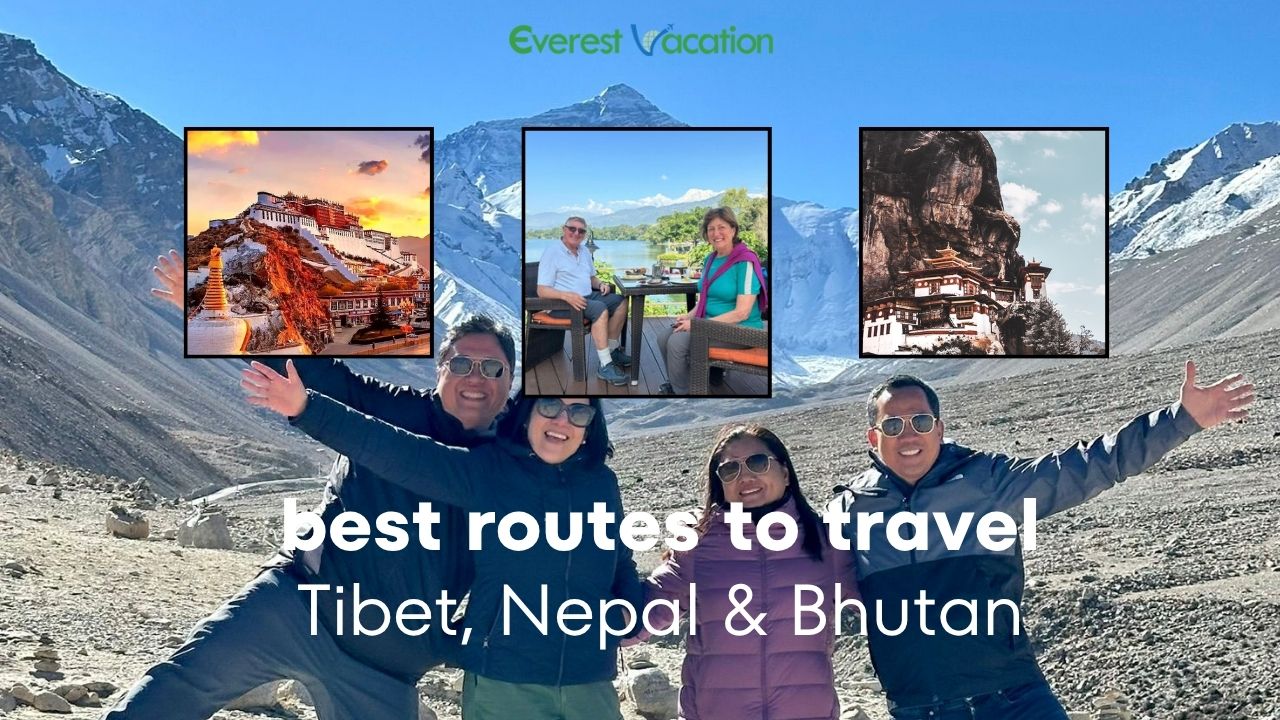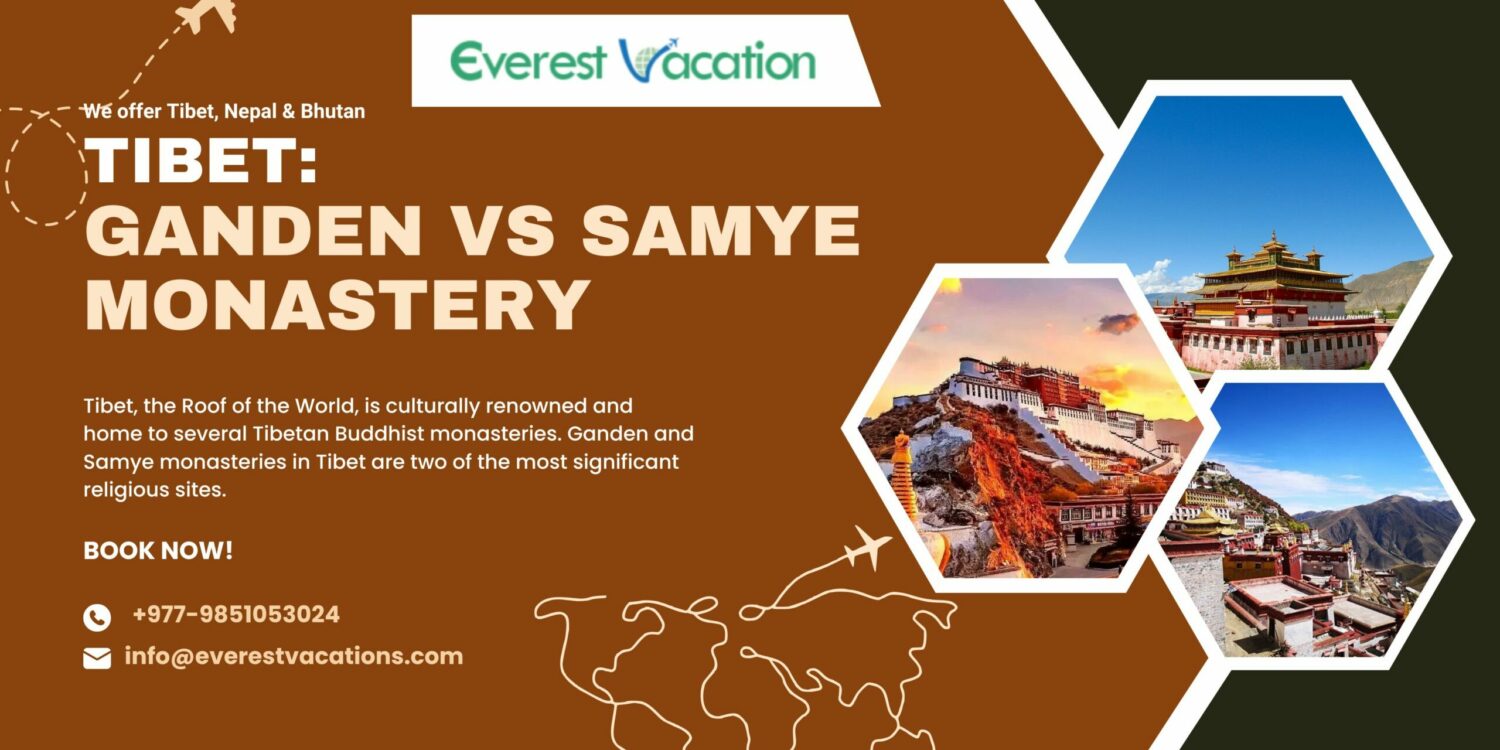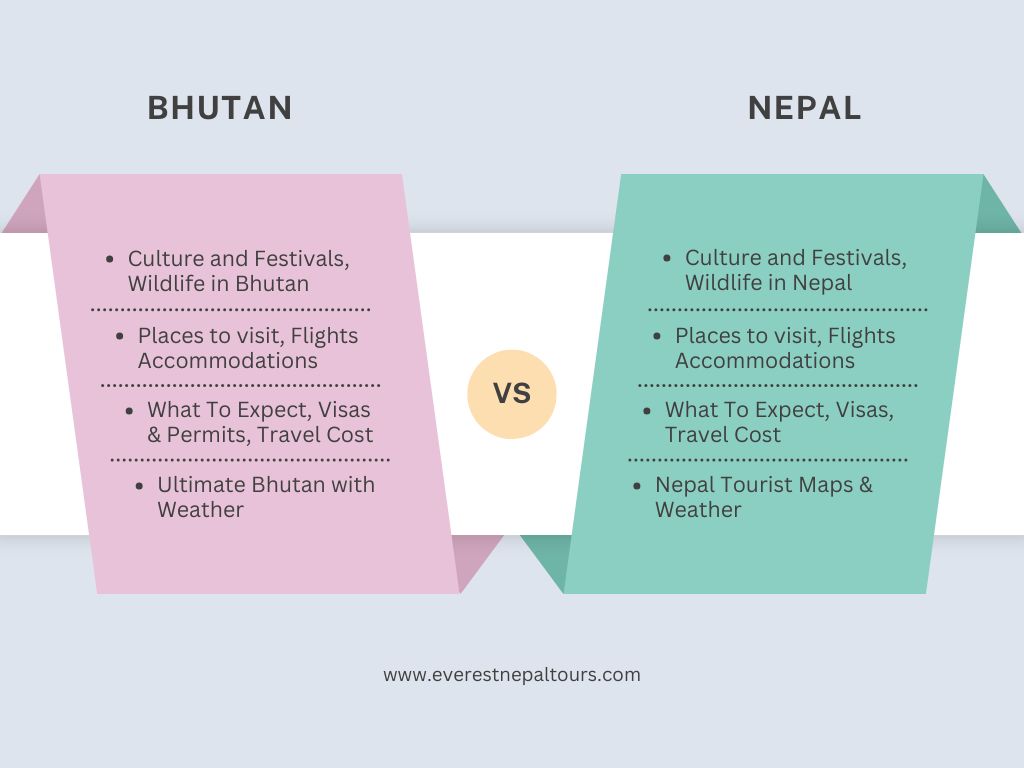Nepal Bhutan Tour vs Nepal Tibet Tour are both fascinating options for travelers seeking diversity. These tours take you through these destinations rich in culture and natural beauty, attracting visitors from all over the world. Each destination offers fabulous landscapes and a blend of cultural and natural heritage. To make your decision easier, we’ve provided detailed answers to common questions that can help you choose the tour that suits your preferences, or even both if you wish.
1. Visa Requirements, Permits and Regulations:
For Nepal, you can easily get an on-arrival Visa.
For Bhutan, with the help of your tour operator, you can easily apply for an online Visa which requires a digital copy of a valid passport and digital photo.
For Nepal, you can easily get an on-arrival Visa.
For Tibet, obtaining a Tibet group visa requires your original passport and photos, and typically takes a minimum of 4 working days when applying from Kathmandu. If you plan to travel to Tibet via China mainland, you are required to have a Chinese Visa and a Tibet Travel Permit in advance before flying to Tibet.
Tibet permit applications usually take 12 working days and require travelers to provide documents, sent from their home country to the travel agency.
Note: We will look after your visa, and permit requirements.
2. Accessibility
Bhutan: Bhutan offers convenient air access, allowing you to book flights tailored to your preferences through your tour operator. Flights from Kathmandu (Nepal) to Bhutan are readily available daily. If you want to travel overland to Bhutan, you can only do so from one or two locations only from India.
Tibet: Getting to Tibet is simple whether you choose to travel overland (3-4 days drive) from Nepal to Lhasa (Tibet) or fly in from major Chinese cities. Direct flights from Kathmandu to Lhasa have not yet resumed following the COVID-19 pandemic. You can trust us to arrange all the logistical details of your tour, ensuring a smooth and hassle-free experience.
3. Cultural Highlights:
Nepal and Bhutan:
- Rich Buddhist culture in both nations Nepal and Bhutan
- Stunning monasteries, stupas, and unique architecture in both nations
- Amazing cultural festivals in both nations (Jatras in Nepal and Tsechu in Bhutan)
- Unique Hindu Culture and Durbar Squares in Nepal
- Most renowned Tiger’s Nest, Great Buddha Dordenma, and Dzongs (Punakha, Paro) in Bhutan
- Pashupatinath, Boudhanath, and Lumbini in Nepal
Nepal and Tibet:
- Deep Buddhist culture in Nepal and Tibet
- Cultural festivals such as Sho dun in Tibet and Jatars (Indra Jatra, Gaijatra, Machhindranath) in Nepal
- Unique Hindu Culture and Artistically Beautiful Durbar Squares in Nepal
- Famous landmarks and monuments like Potala, and Norbulingka Palace in Tibet
- Ancient Pashupatinath Temple and Boudhanath Stupa, Lumbini (Birth place of Lord Buddha) in Nepal
4. Natural Attractions:
Nepal and Bhutan:
Nepal’s Natural Attractions:
- Mount Everest: The world’s highest peak which is at an elevation of 8848.86 m
- Annapurna Region: For outstanding mountain scenery and classic trekking in the vicinity of forested trails
- Pokhara Valley: The tourist capital famous for its sunrise viewpoint, snow-capped mountains, and serene lakes
- Chitwan National Park: The park is home to diverse wildlife, including Royal Bengal tigers, one-horned rhinos, and diverse bird species.
- Gosaikunda: A sacred lake in the Langtang region surrounded by spectacular mountain views
- Kathmandu Valley: Settled amidst lush landscapes with spectacular Himalayan backdrops, it’s an ideal destination for short hikes and perfect views.
Bhutan’s Natural Attractions:
- Paro Valley: Surrounded by lush green hills offering picturesque vistas
- Phobjika Valley: The valley is famous for its endangered black-necked crane habitat
- Jigme Dorji National Park: The pristine wilderness, flora and fauna in Bhutan’s largest national park
- Bumthang Valley: A peaceful and culturally rich region with abundant natural beauty
- Haa Valley: The sky burial ground which is ideal for the superb view of Mountain ranges: Mt. Jumolhari and Jichu Drake peak
- Tiger’s Nest: The iconic monastery perched on a cliff offering breathtaking views and spiritual significance
- Dochu La Pass: Witness a wonderful view of the Himalayas, and terrain fields, and experience breezing fresh air
Nepal and Tibet:
Tibet’s Natural Attractions:
- Potala Palace: Witness the panoramic views of Lhasa and the surrounding mountains
- Yamdrok Lake: This stunning turquoise alpine lake which lies at an altitude of 4,441 meters
- Namtso Lake: The sacred crystal-clear lake of Tibet in the surrounding snow-capped peaks
- Mount Everest (Qomolangma): The view of the world’s highest peak from the base of Rongbuk Monastery
- Rongbuk Glacier: The world’s highest glacier near Mt. Everest
- Mount Kailash: A holy peak in the Himalayas attracting pilgrims from around the world
Nepal’s Natural Attractions:
- Mount Everest: The world’s highest peak which is at an elevation of 8848.86 m
- Annapurna Region: For outstanding mountain scenery and classic trekking in the vicinity of forested trails
- Pokhara Valley: The tourist capital famous for its sunrise viewpoint, snow-capped mountains, and serene lakes
- Chitwan National Park: The park is home to diverse wildlife, including Royal Bengal tigers, one-horned rhinos, and diverse bird species.
- Gosaikunda: A sacred lake in the Langtang region surrounded by spectacular mountain views
- Kathmandu Valley: Settled amidst lush landscapes with spectacular Himalayan backdrops, it’s an ideal destination for short hikes and perfect views.
5. Cost:
The cost of any tour depends on the tour duration, itinerary, accommodation types, and means of transportation. The tour costs for each country are as follows:
Nepal Tour Cost:
Nepal tours are budget-friendly due to their lower permit costs, and you can get an on-arrival visa, which saves time. You don’t have to pay government fees like in Bhutan or wait as long for permits as in Tibet, making it a quicker and more cost-effective option. The total cost varies depending on your chosen itinerary, accommodation preferences, tour duration, and personal expenses.
Bhutan Tour Cost:
Bhutan Tour cost is slightly more expensive than in Nepal because of the daily government fee of USD 100 per person per night. Other expenses vary depending on your budget. However, getting permits and on-arrival visas is easy and affordable.
Tibet Tour Cost:
Tibet tours can be a bit more expensive than Nepal because you might have to wait a while for visas and permits. Additionally, your total expenses depend on tour duration, chosen itinerary, and personal spending.
6. Religious Attraction Sites:
Nepal and Bhutan:
Nepal’s Popular Religious Attractions:
- Pashupatinath Temple: A sacred Hindu temple and pilgrimage site in Kathmandu.
- Swayambhunath Stupa: An iconic Buddhist stupa renowned as Monkey Temple.
- Boudhanath Stupa: A UNESCO-listed huge Buddhist stupa in Kathmandu.
- Lumbini: The birthplace of Lord Buddha including numerous monasteries
Bhutan’s Popular Religious Attractions:
- Paro Taktsang (Tiger’s Nest): An iconic Bhutanese Buddhist monastery rested on a Cliffside
- Rinpung/Ta Dzong: A large Buddhist monastery of the Drukpa Lineage
- Punakha Dzong: The second largest dzong built without using any nails
- Paro Dzong: A historic fortress is a classic example of Bhutanese architecture
- Tashichho Dzong: A prominent Fortress of the Glorious Religion
- Chimi Lhakhang: Renowned temple for fertility blessings which is dedicated to the ‘Divine Madman’
- Kyichu Lhakhang: One of the oldest temples and has deep spiritual significance in Bhutan
Nepal and Tibet:
Tibet’s Popular Nepal Religious Attractions:
- Potala Palace: A historic and glorious palace which is now a museum listed as a UNESCO World Heritage Site
- Norbulingka Palace: A beautiful summer palace and park highlighting Tibetan architecture
- Tashilhunpo Monastery: One of the most significant monasteries popular for its Maitreya Buddha statue
- Rongbuk Monastery: The world’s highest-situated monastery offers stunning mountain views including Everest.
- Jokhang Temple: Sacred spiritual center for Tibetan Buddhists listed as a UNESCO World Heritage Site
- Drepung, Sera, & Ganden Monastery: The Great three largest monasteries in Tibet
Nepal’s Popular Nepal Religious Attractions:
- Pashupatinath Temple: A sacred Hindu temple and pilgrimage site in Kathmandu.
- Swayambhunath Stupa: An iconic Buddhist stupa renowned as Monkey Temple.
- Boudhanath Stupa: A UNESCO-listed huge Buddhist stupa in Kathmandu.
- Lumbini: The birthplace of Lord Buddha including numerous monasteries
7. Altitude and Acclimatization:
Nepal and Bhutan:
During the Nepal and Bhutan tour, you’ll mostly be sightseeing in lower-altitude city areas. So, you don’t need to worry about high altitudes or getting used to them. This makes it easy and comfortable for tourists to explore and enjoy the local attractions without altitude problems.
Nepal and Tibet:
While touring Nepal and Tibet, travelers should exercise caution as Lhasa is situated at a high elevation. Traveling to Tibet can be challenging in terms of altitude, but with proper guidance and safety measures, it’s manageable. Nepal’s sightseeing is mostly in city areas which are usually at lower altitudes. So, you don’t need to worry about high elevations and acclimatization.
8. Local Cuisine:
Bhutan and Nepal:
Nepal:
Nepal offers a diverse culinary experience with popular dishes like Nepali Dal Bhat, Momo dumplings, Samaya Baji Set, Bara lentil patties, and Thukpa noodle soup. The sweet Yomari (sweet steamed dumplings), Sel Roti (crispy rice doughnuts), Chhoila (spiced grilled meat), Khapsey (deep-fried pastry), and Laphing (spicy mung bean noodles) also attract many.
Bhutan:
Ema Datshi, a spicy chili and cheese dish, is Bhutan’s most popular culinary delight. Alongside this favorite, Bhutan offers a unique range of local cuisines to explore. Such as dishes like Gondomaru (a spinach-based dish), Eze (a traditional Bhutanese stew), Kule (a hearty buckwheat porridge), Momo (delectable dumplings), Tsampa (roasted barley flour), Doma (betel leaf with areca nut), and Kewa Datshi (potatoes in cheese sauce).
Nepal and Tibet:
Tibet:
Tibetan cuisine features dry yak meat, tsampa (roasted barley flour), Tibetan momo (dumplings), sausages, zhe-se (fried dough), and thukpa (noodle soup). Tibetan yogurt, barley wine, and butter tea are often enjoyed alongside meals, providing a glimpse into the region’s distinctive flavors.
Nepal:
Nepal offers a diverse culinary experience with popular dishes like Nepali Dal Bhat, Momo dumplings, Samaya Baji Set, Bara lentil patties, and Thukpa noodle soup. The sweet Yomari (sweet steamed dumplings), Sel Roti (crispy rice doughnuts), Chhoila (spiced grilled meat), Khapsey (deep-fried pastry), and Laphing (spicy mung bean noodles) also attract many.
9. Tourist Season:
Nepal and Bhutan:
The best times to visit Nepal and Bhutan are spring (March to May) and autumn (September to November) seasons. These months have nice weather, moderate temperatures, and clear views, making them great for tourists. Throughout the year, a tour of Nepal and Bhutan is possible, with spring and autumn being the ideal seasons.
Nepal and Tibet:
The best time to visit Tibet is from April to October, and these months are also great for traveling to Nepal. From March to May and September to November, Nepal has nice weather and temperatures, which means travelers can enjoy beautiful views. Throughout the year, Nepal tours are feasible, but the ideal months for visiting Tibet are limited to March to May and September to November due to weather conditions.



